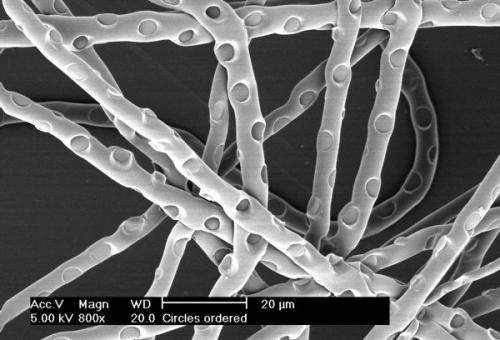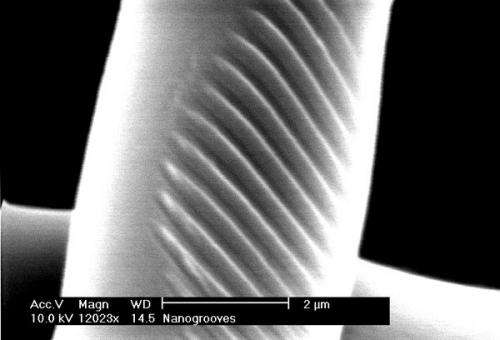Patterns on extremely small fibres: Study pushes regenerative medicine another step forward

Researchers at the MIRA research institute have succeeded in imprinting microscopically small shapes on the surfaces of miniscule fibres. They were able to create all kinds of patterns on the surfaces of fibres just six micrometres in diameter. These fibres can be used to steer stem cell development in a specific direction. For instance, if you want to create bone cells then it is best to use fibres with a ribbed pattern. This research was recently published in the scientific journal Small.
Stem cells are capable of developing into any type of cell. One of the factors that determines which type of cell they become is the structure of the substrate on which these stem cells are located. So you can steer the development of stem cells by carefully selecting the type of surface on which they are placed.
Researchers at the University of Twente have now managed to imprint standard, selected patterns on the miniscule polymer fibres on which stem cells are cultured. Using a special "stamping" technique, known as NanoImprint Lithography, they were able to imprint microscopically small patterns, such as ridges, pyramids and pillars, on self-made fibres just six micrometres in diameter.

Tool
These fibres provide researchers with a new tool for getting stem cells to differentiate into specific cell types. For the purposes of this study, the researchers used adult human stem cells. Lorenzo Moroni, one of the scientists involved, believes that these fibres can be used to systematically investigate the effect of various substrates. One of the study's findings was that fibres with a ribbed pattern produced the best bone cells.
37 degrees Centigrade
Not only were the researchers able to impress patterns on these miniscule fibres, but they managed to do so at physiological temperatures (around 37 degrees Celsius). This is an enormous advantage in terms of future applications, as it means that this method is also suitable for all kinds of biological materials.
The article is titled "A Fast Process for Imprinting Micro and Nano Patterns on Electrospun Fiber Meshes at Physiological Temperatures."
More information: A Fast Process for Imprinting Micro and Nano Patterns on Electrospun Fiber Meshes at Physiological Temperatures, Small, 2013.
Journal information: Small
Provided by University of Twente
















